Product Requirements:
Device:
PDAs of dimensions 5 1/4 x 3 1/4"
When I was at Fall Comdex 2001 I saw a new
RhinoSkin case that practically had me salivating. A nice front flip up case
that used elastic plastic rings to hold III-style devices in place, the Molded
EVA Foam Sportcase was calling my name.
Unfortunately it didn’t come home with me. Luckily I was able to get one
later to review. Unfortunately it was a disappointment.
At 5.6 x 3.5 x 1.35 inches and weighing 3.2 ounces with the belt clip, this
case is not small or particularly light. It adds a good inch to the length of a
III-style device and almost exactly doubles its thickness. If you like thin and
trim this case isn’t for you.
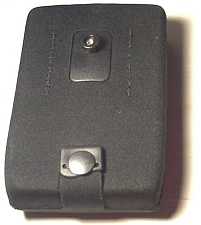
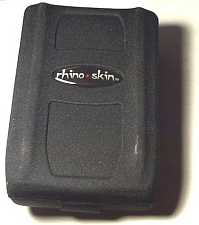
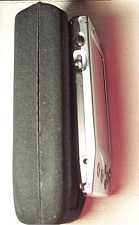
Made of lightweight EVA foam covered in a light woven black stretched lycra,
the case has a clamshell style. A small strap with a snap slides around the
bottom of the case to the back to hold the case closed. The front has some
sculpting to give the case a more interesting look, and there is a large plastic
button with the RhinoSkin logo on it. It’s fairly nice looking, in a sporty way.
The inside of the case resembles a dugout canoe, in that it has two deep
caverns. The bottom one holds the device and has a thin plastic protective sheet
that gives the case most of its stiffness. It’s the type of sheet most cases
would have under the fabric on the screen side of the case to give added protection,
not on the opposite side. I’m not sure why RhinoSkin decided on this placement
– I find it odd.
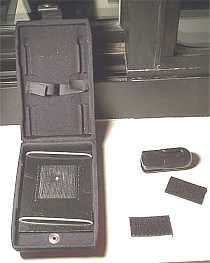
While we’re on the subject of protection, the case has quite a lot of give.
As far as I can tell this plastic sheet is the only stiffening used in the case,
so it’s pretty easy to twist or otherwise bend out of shape. I don’t think this
is a real problem, but if you like stiff cases that don’t have any give this
isn’t the case for you.
Palms can be fastened to the case in two ways – using Velcro or using
slightly elastic plastic rings. I won’t use Velcro on a Palm, so I can’t comment
on how well the Velcro holds, but the case has one of the largest pieces of
Velcro I’ve seen. The hook piece is sewn into the case, inside a square cutout
area of the plastic protective sheet. The case also comes with two large
rectangular pieces of adhesive loop Velcro that cover the entire hook piece and
then some. There is just enough room to attach one of these pieces to a HandEra
330 above the battery door without covering the reset hole, but you will have to
cover the label with serial number.
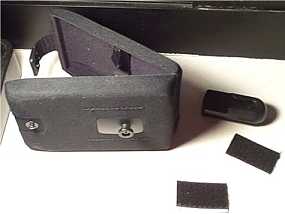
I like the plastic ring system also provided. Consisting of two somewhat
elastic plastic rings that fit around the device – one on the bottom and one on
the top, they stretch enough to make it fairly easy to get the device into the
case but are snug enough to hold it securely once it’s been positioned. I am
comfortable holding the open case upside down using this system.
The rings do require a little adjustment to ensure that they don’t block any
of the buttons, and with the HandEra 330 the top ring seems to naturally hook
into the small crevice for the LED. If you want to see the LED while the device
is in the case, you’ll have to be very careful to always re-adjust this ring.
Regardless of the attachment style, given the dugout style of the case, you
won’t have access to any of the sides, the top, or the bottom of your device.
You won’t be able to adjust the contrast on devices with contrast wheels, use
the jogdial on a HandEra 330, hotsync, access SD or CF cards, remove the stylus,
or use IR while the device is secured. If you use the ring system, you can use
IR by sliding off the top ring and lifting the top of the unit. You can also
access the jog wheel and expansion slots this way. It is possible but difficult
to access contrast wheels by lifting the top.
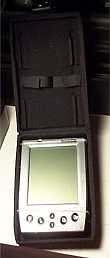
The top section that becomes the lid of the case has two stylus holders – one
on each side. Grooved channels that run most of the length of the case, these
holders should fit any stylus that fits in a III silo (I tried the default Palm
III stylus, a pro-techniq stylus, and a Landware floating*point stylus).
However, you need to perfectly position the stylus or it won’t hold. Two ribbons
are provided, one for each side, to help you remove the stylus. Simply place the
ribbon over the channel, hold the end up, then put the stylus in. When you want
to remove the stylus, lift the ribbon and it pops out. If you don’t use the
ribbons, the stylus is slightly but not significantly easier to get in the case
and much more difficult to remove. I suggest using the ribbons.
The case also has a removable belt clip. The back of the case has a
protruding hard plastic hook that slides onto the clip only when the clip is
turned sideways. Once on, the clip can only be removed by pressing in the end of
the clip when it’s in the sideways position. It’s very secure – the case will
tear before the clip will give. I am, in general, not fond of belt clips because
it’s too easy to have an accident. I am comfortable that with this belt clip my
case isn’t going to fall off.
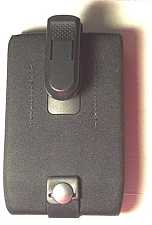
One thing of interest with the clip is that unlike most belt clips, it
doesn’t hang downward when in use. By this I mean in order to have the hinge
facing upward so you can use the clip, the bulk of the clip must be positioned
about the connection point. In this configuration the clip actually protrudes
above the case. Most clips connect at their hinge point and hang downward. This
caused me no end of confusion, as I kept trying to use the clip when it was
upside down and got very frustrated when it wouldn’t open.
RhinoSkin is known for quality products. Their cases generally use the best
materials, incorporate excellent designs, and are created with the best
workmanship. I expect a lot from RhinoSkin and they usually deliver.
However, in this case, they did not. The edges of the case are already
beginning to fray after less than a month of use and there are spots where the
nylon has thinned considerably to the point where you can almost see the white
foam. The stitching on the back of the case – used to hold in the plastic
protective plate that goes behind the device and to hold in the Velcro – has
loose threads sticking up and generally doesn’t blend in well with the case and
there are one or two stray dots of glue on the inside cover. The metal snap that
holds the case closed is starting to tarnish. The entire case is a dust magnet –
there are specks of this and that everywhere. In short, the case had some issues
to begin with and does not hold up well over time.
Price: $29.95
Pros:
Very secure belt clip
Plastic ring system securing the Palm
Ribbons make removing stylus much easier
Cons:
Must fully or partially remove Palm to access IR, hotsync expansion slots
Adds a lot of bulk to the device
Shoddy workmanship and materials
Android 13 Barcode Scanner Handheld Mobile Computer, 5.5-inch Touchscreen PDA Scanner with Integrated Honeywell 1D & 2D Bar Code Scan Engine, WiFi & 4G LTE, for Warehouse & Logistics
$399.99 (as of December 19, 2025 05:17 GMT -05:00 - More infoProduct prices and availability are accurate as of the date/time indicated and are subject to change. Any price and availability information displayed on [relevant Amazon Site(s), as applicable] at the time of purchase will apply to the purchase of this product.)NETUM Android 11 Handheld Barcode Scanner Terminal Mobile Computer, Wi-Fi 4G BT NFC PDA for Inventory Warehouse, Retails Management (Q500 PDA)
Product Information
| Price: | 29.95 |
| Manufacturer: | Rhinoskin |
| Pros: |
|
| Cons: |
|



Gadgeteer Comment Policy - Please read before commenting
Post your comments here on the Sony PEG-WL110 Compact Flash Wireless LAN Card.
http://www.the-gadgeteer.com/sony-wifi-cf-card-review.html
Just click the POST REPLY button on this page.
how about battery life? was it really draining to use the wireless connection. i am using a NX60 and the battery life for it is only adequate, without powering connections.
dotdotdot,
I use the WiFi card sporadically. I will check e-mail then turn it off, check a web site then turn it off, or chat from my living room for a little bit and then turn it off, several times a day. With that type of use, battery loss is minimal. Plus I keep my backlight on the dimmest setting (which on the NZ is actually as bright as my Tungsten T was on the middle setting).
If you would like me to test a certain scenario – name it and I will give it a shot. Just be aware that I am using an NZ90, which may not have the same battery life as your NX60.
Judie :0)
Hi,
I have the WL100 (the predecessor to the WL110 that was reviewed) on my NX70. I find that I can ~2h of surfing time on a full charge. I say ~ since I never run my battery all the way down. After 2h of surfing, the battery is low enough that I discontinue usage.
I would prefer the battery life to be better but based on what I know, it’s the best that the NX70 (or the NX60) can deliver. I do have a homebrew battery extender that work quite well…
The bigger criticism I have for Sony is the lack of any signal strength indicator (as on Palm-branded device or the newer UX-50) and/or sniffers (as on PPC). The absence of both makes me think that WiFi is kinda half-baked on the current CLIE.
George
I totally agree with you that there should have been a signal strength indicator – of some kind…but I won’t go so far as to say that its abscence makes this CLIE’s WiFi half-baked. It’s just not as elegant as it could have been.
Judie :0)
Well, it may be a harsh judgement but it’s also out of frustration of being so close and yet so far. My other gripes:
1. PTL (Page Too Large) errors crop up far too often. Granted, this is really Acess’ problem but someone needs to work this out in the real world.
2. Management of popup and/or new windows is kinda hit-and-miss. For example, it renders my office’s internal portal kinda useless.
3. Sony needs to make the WiFi API public to allow third-party to fill in the missing pieces.
4. Sony needs to improve the driver and/or network setup. Given Sony’s track record though, I’m quite fearful that when WPA supersedes WEP that my card will be relegated to the dustbin for lack of a new driver.
George
PTL errors occur because the web page is too large to view in portrait mode…if NetFront (or some other browser) would (please!) create a landscape mode, then I bet those errors would go away. Correct me if I am wrong.
I am afraid that with the upcoming UX model, which includes built-in WiFi, Sony may not pursue any improvements for those that are using the CF WiFi cards. Hopefully developers will step up to the plate – as they so often have to.
Judie :0)
How does the WL-100 card compare to using the Tungsten C? I’m thinking of getting a NX-70 and would like to do Wi-Fi. I’ve tried the Tungsten C and it works very well as far as finding a Wi-Fi network and connecting. Does the Sony PDAs with the WL-100 work as easy? BTW. I used to live in San Angelo and taught at ASU. How hot is it?
Dan
Dan,
I think that the WL-110’s range is at least as good as the Tungsten C’s – in my case it seemed even better. The biggest difference is that the C has WiFi built in, so there is no extra part to loose. Also, there is no software indicator for signal strength when you use the Sony WiFi card. Otherwise, service is comperable between the two, and just as easy to connect.
I went to ASU from 85-87 and 97-2001. What did you teach?
Today is nice (78 & sprinkling!), but it has been over 100 far too many days this summer. I’ve been wishing we were freezing our tushes off in Scotland again. 😉
Judie :0)
For those not willing or able to make their own extenders, this one seems interesting. Could be helpful on a long flight for a pda or laptop, extended or repeated wireless sessions, quick AC-free top offs, or field use, if the cord is long enough to keep the charger in a bag or on a belt. It doesn’t look too big a deal to carry, especially if it can extend the life of a high-end Sony 3-4 times.
Herer it is if you folks haven’t seen it. Same product, same site, different descriptions of use and specs:
http://web1.applelaptopbattery.com/ccp5/cgi-bin/cp-app.cgi?rrc=N&pg=prod&ref=PR2
http://www.laptopsforless.com/pr2-ipaq38details.htm
Short review from PocketPC Mag:
http://www.pocketpcmag.com/Mar03/guptas.asp
Hi
I want to buy the NZ-90 plus the WL110 wifi card, but I see last week a review in wich there said that with this wifi card yo can’t recognized the posibles wireless network. That will limit me to conect in some places out of my house.
Is that true???
There exist an extra software for recognizing wireless networks??
Thanks.
Jaime.
Hi, where can i download the right NetFront Internet Browser for Sony Clie NZ90??? A trial or anything please, Thanks!